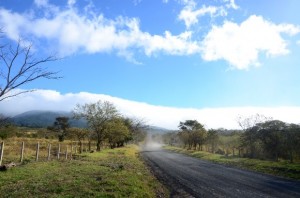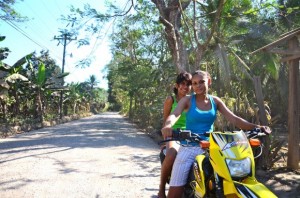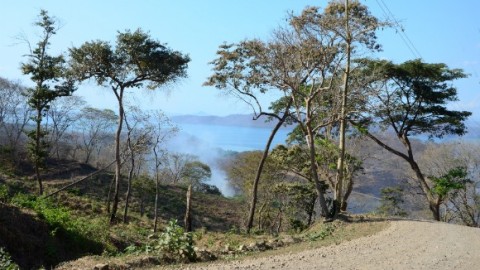Take a look at a road map of Costa Rica’s Nicoya Peninsula and you’ll see a jumble of squiggly lines that seem to meander in circles with no clear pattern. Before setting off in a rental car from Santa Teresa, at the foot of Nicoya, heading towards Rincon de la Vieja National Park near the Nicaraguan border, I was a bit intimidated by the navigational task at hand. And I’d heard that the roads in this part of the country were a disaster.
 But when local cab drivers told me it would cost at least $300 to take a cab to Rincon, I decided to take the plunge on my own in a rental car. I found three rental car companies in Santa Teresa and Budget had the “cheapest” price: $280 to rent an automatic transmission Toyota Rav-4 for two days, including a GPS, a child seat and a surcharge to drop it off at the airport in Liberia. It was more than double the highest price I’d ever paid for a car rental in my life, but after spending our first six days in country careless and at the mercy of taxi drivers, it felt great to have some wheels and a bit of freedom.
But when local cab drivers told me it would cost at least $300 to take a cab to Rincon, I decided to take the plunge on my own in a rental car. I found three rental car companies in Santa Teresa and Budget had the “cheapest” price: $280 to rent an automatic transmission Toyota Rav-4 for two days, including a GPS, a child seat and a surcharge to drop it off at the airport in Liberia. It was more than double the highest price I’d ever paid for a car rental in my life, but after spending our first six days in country careless and at the mercy of taxi drivers, it felt great to have some wheels and a bit of freedom.
We spent much of the first two hours of our trip on Route 160, which is mostly unpaved and ranges in quality from not-too-bad to thank-God-I’m barreling-down-this-cratered- track-in-a-rental-car-rather-than-my-own-vehicle bad. The thought occurred to me that the high cost or rental cars in Costa Rica must be due at least in part to the poor quality of the roads. I was driving carefully but the road was beating the hell out of our Rav-4.
I’m generally an impatient traveler who would rather take the fastest route between two points – no slow-going, scenic routes for me – but I was surprised by how much I enjoyed barnstorming through the decrepit, neglected byways of Guanacaste. The poor quality of the road forced us to take it slow, allowing us to digest the beauty and serenity of slumbering villages where we saw clusters of teens gather to check out someone’s new moped, men in colorful T-shirts and baseball caps selling watermelons and coconut water on the side of the road, and plenty of farm animals roaming free in the streets. In these timeless places, no one had air conditioning – life was lived in the streets and people had their doors open, so we could see right inside people’s homes.
The twisting, dipping and soaring back roads of Guanacaste are filled with buena vistas. Costa Rica literally means “rich coast” and nowhere in the country is that moniker better earned than in Guanacaste. Car travel in the U.S. can be mind numbingly boring. The physical terrain changes but the retail landscape is always familiar and there are no farm animals or people to look at on our highways. Here, there was someone or something to look at everywhere.
In one sleepy village, I hopped out to photograph a pair of teenage girls on a motorcycle and they acted like they’d been chosen to grace the cover of Vogue. In another, a collection of men made a futile attempt to explain what goes on at a lavacar. (Someone help me out here – is this a place to bring animals for a bath?)
chosen to grace the cover of Vogue. In another, a collection of men made a futile attempt to explain what goes on at a lavacar. (Someone help me out here – is this a place to bring animals for a bath?)
On the road leading to a place called Playa Gigante, I stopped to take a photo of a handsome old man tidying his yard with a machete and was surprised when he greeted me in English.
“Hello, my friend,” he said. “What brings you here?”
“Actually, I just wanted to take your photo,” I admitted. “Do you mind?”
“I’m never too busy to make a new friend,” he said, extending his hand to introduce himself.
His name was Christian and he learned English while living in Glendale, California, in the 1980s. I asked him why he came back to Costa Rica and he said that his parents were old and he needed to come back to take care of them.
“Do you like it here?” I asked.
“Of course,” he said, looking around at the collection of tidy, modest homes. “We have everything here and it’s nice and quiet.”
Last year, Costa Rica was rated the happiest country in the world by The New Economics Foundation and indeed, most Costa Ricans will tell you that they live in a truly wonderful, if expensive, place.
Eventually we merged onto the paved Pan-American Highway, which was faster but less interesting and we made the trip to Rincon in about five leisurely hours with plenty of stops for random conversations and photo opps. If you find yourself in this part of the world, I highly recommend taking the time to get lost on the back roads of Guanacaste. You won’t get anywhere fast but you won’t soon forget the experience.
by Dave Seminara, gadling.com
[Photo credits: Dave Seminara]

